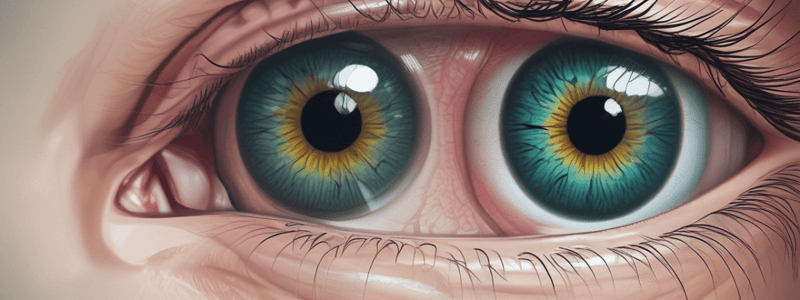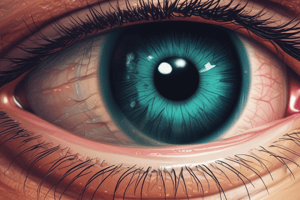Podcast
Questions and Answers
What percentage of individuals may exhibit physiological anisocoria?
What percentage of individuals may exhibit physiological anisocoria?
- 20% (correct)
- 30%
- 40%
- 10%
What is the most common cause of Horner's syndrome in children?
What is the most common cause of Horner's syndrome in children?
- Viral infections
- Carotid dissection
- Neoplasia
- Birth trauma (correct)
Which of the following is a predisposing factor for tonic pupil?
Which of the following is a predisposing factor for tonic pupil?
- Male gender
- Autonomic neuropathy
- Age above 60 years
- Female gender (correct)
What is the estimated prevalence of tonic pupil in the general population?
What is the estimated prevalence of tonic pupil in the general population?
Which of the following is a characteristic feature of Argyll Robertson pupil?
Which of the following is a characteristic feature of Argyll Robertson pupil?
What is the estimated birth prevalence of Horner's syndrome?
What is the estimated birth prevalence of Horner's syndrome?
What is the age range in which tonic pupil commonly occurs?
What is the age range in which tonic pupil commonly occurs?
What is the underlying pathology in Horner's syndrome?
What is the underlying pathology in Horner's syndrome?
What condition is associated with Argyll Robertson pupil?
What condition is associated with Argyll Robertson pupil?
What is the characteristic feature of physiological anisocoria?
What is the characteristic feature of physiological anisocoria?
What is the primary cause of the interruption of the oculosympathetic innervation in Horner's syndrome?
What is the primary cause of the interruption of the oculosympathetic innervation in Horner's syndrome?
What is the characteristic commonality between tonic pupil and Horner's syndrome?
What is the characteristic commonality between tonic pupil and Horner's syndrome?
What is the estimated proportion of individuals who may exhibit unequal pupil sizes in the absence of an underlying pathological cause?
What is the estimated proportion of individuals who may exhibit unequal pupil sizes in the absence of an underlying pathological cause?
What is the age range in which Horner's syndrome is more commonly seen in?
What is the age range in which Horner's syndrome is more commonly seen in?
What is the association between Argyll Robertson pupil and neurosyphilis?
What is the association between Argyll Robertson pupil and neurosyphilis?
What is the characteristic feature of the near reaction in Argyll Robertson pupil?
What is the characteristic feature of the near reaction in Argyll Robertson pupil?
What is the primary difference between tonic pupil and Horner's syndrome?
What is the primary difference between tonic pupil and Horner's syndrome?
What is the characteristic feature of idiopathic anisocoria?
What is the characteristic feature of idiopathic anisocoria?
What is the common association between tonic pupil and other conditions?
What is the common association between tonic pupil and other conditions?
What is the characteristic feature of the Holmes-Adie syndrome?
What is the characteristic feature of the Holmes-Adie syndrome?
Which of the following conditions is typically associated with a benign course?
Which of the following conditions is typically associated with a benign course?
What is the primary mechanism underlying tonic pupil?
What is the primary mechanism underlying tonic pupil?
Which of the following is a predisposing factor for both tonic pupil and Horner's syndrome?
Which of the following is a predisposing factor for both tonic pupil and Horner's syndrome?
What is the characteristic feature of the pupillary light reflex in Argyll Robertson pupil?
What is the characteristic feature of the pupillary light reflex in Argyll Robertson pupil?
Which of the following conditions is associated with a higher prevalence in women?
Which of the following conditions is associated with a higher prevalence in women?
What is the characteristic feature of the near reaction in physiological anisocoria?
What is the characteristic feature of the near reaction in physiological anisocoria?
Which of the following conditions is associated with a higher risk of carotid dissection or neoplasia?
Which of the following conditions is associated with a higher risk of carotid dissection or neoplasia?
What is the primary difference between tonic pupil and Horner's syndrome?
What is the primary difference between tonic pupil and Horner's syndrome?
Which of the following conditions is typically seen in association with generalised peripheral or autonomic neuropathies?
Which of the following conditions is typically seen in association with generalised peripheral or autonomic neuropathies?
What is the characteristic feature of the pupillary light reflex in physiological anisocoria?
What is the characteristic feature of the pupillary light reflex in physiological anisocoria?
What is the term for unequal pupil sizes in the absence of an underlying pathological cause?
What is the term for unequal pupil sizes in the absence of an underlying pathological cause?
What is the estimated prevalence of tonic pupil in the general population of women?
What is the estimated prevalence of tonic pupil in the general population of women?
What is the characteristic feature of the pupillary light reflex in tonic pupil?
What is the characteristic feature of the pupillary light reflex in tonic pupil?
What is the most common association with Horner's syndrome in children?
What is the most common association with Horner's syndrome in children?
What is the characteristic feature of Argyll Robertson pupil in terms of the near reaction?
What is the characteristic feature of Argyll Robertson pupil in terms of the near reaction?
What is the underlying pathology of Horner's syndrome?
What is the underlying pathology of Horner's syndrome?
What is the estimated prevalence of physiological anisocoria in the general population?
What is the estimated prevalence of physiological anisocoria in the general population?
What is the characteristic feature of tonic pupil in terms of the pupillary light reflex?
What is the characteristic feature of tonic pupil in terms of the pupillary light reflex?
What is the association between Horner's syndrome and carotid dissection or neoplasia?
What is the association between Horner's syndrome and carotid dissection or neoplasia?
What is the characteristic feature of idiopathic anisocoria?
What is the characteristic feature of idiopathic anisocoria?
Flashcards are hidden until you start studying
Study Notes
-
Pupil anomalies can be benign, but may also be the first or only manifestation of a serious or even life-threatening disorder.
-
Physiological (‘simple’) anisocoria is a condition where pupil sizes are unequal in the absence of an underlying pathological cause, and is found in up to 20% of individuals, with increased prevalence with age.
-
Tonic (Adie’s) pupil is caused by parasympathetic denervation at the level of the ciliary ganglion, and is most commonly seen in women (2.6:1) aged 20-40 years, with a prevalence of 2 per 1,000 of the general population.
-
Tonic pupil is usually idiopathic, but can be associated with viral infections, connective tissue diseases, and generalised peripheral or autonomic neuropathies.
-
Horner’s syndrome is caused by interruption of the oculosympathetic innervation at any point along the neural pathway from the hypothalamus to the orbit, and is rare in adults, with a birth prevalence of 1 in 6250 for those with a congenital onset.
-
Horner’s syndrome can be benign or occur after surgery, but can also indicate a carotid dissection or neoplasia.
-
Argyll Robertson pupil is associated with neurosyphilis, and is thought to result from a lesion in the midbrain that disables the pathway for the pupillary light reflex.
-
Female gender is a predisposing factor for tonic pupil, and birth trauma is the most common cause of Horner’s syndrome in children.
-
Holmes-Adie syndrome is a condition where tonic pupil is associated with absent or poor tendon reflexes.
Studying That Suits You
Use AI to generate personalized quizzes and flashcards to suit your learning preferences.




